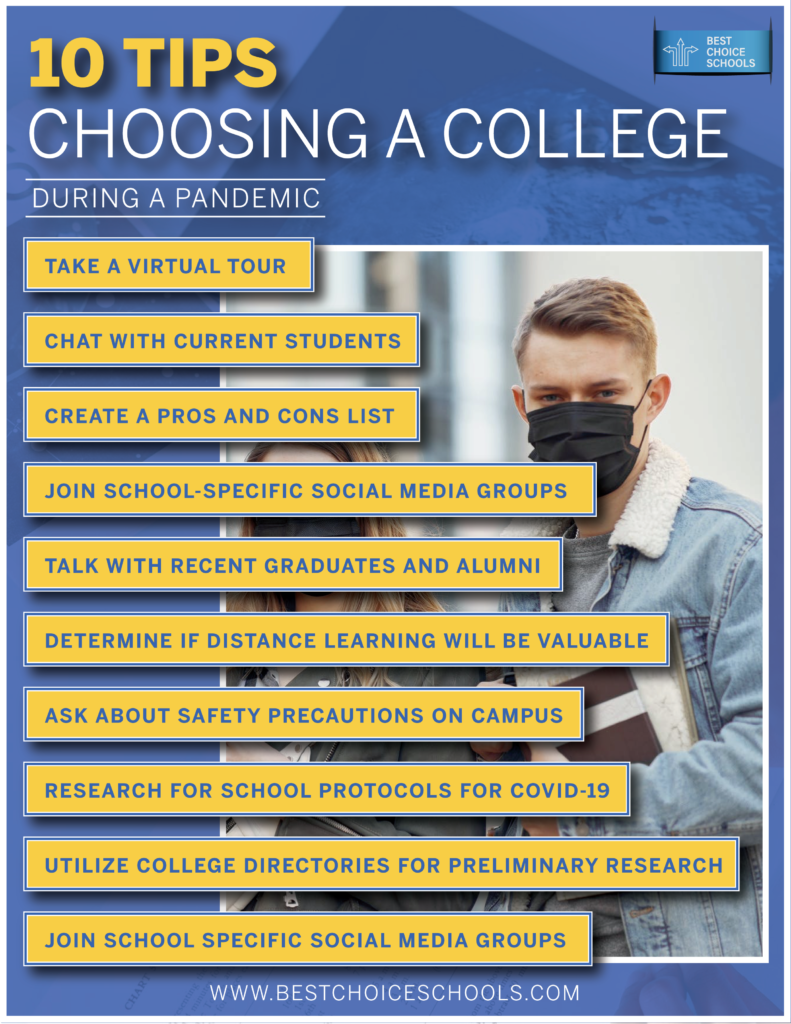By Kelsey Fox

The global COVID-19 pandemic has negatively affected just about everyone, including soon-to-be college students. This year, tens of thousands of high school seniors are facing canceled college visits and the difficult task of choosing a college without visiting.
Fortunately, between social media and the worldwide web, we now have more information about individual schools than ever before. This makes it far easier to choose the right college without ever stepping foot on campus — even if a few extra tasks and a little more imagination are required. Below, we walk you through choosing a college in just 10 easy steps.
1. Utilize College Directories for Preliminary Research

Look on the bright side: without the added expense of visiting each and every college that interests you, you can make an even longer list of potential schools! Still, it is in your best interest to get any list you end up with narrowed down quickly. To get started, begin by compiling a list of everything you want included in your college experience. This list might include a certain distance from home, the opportunity to participate in a certain club or sport, and the availability of a specific major or minor. Have a conversation with your parent(s) about a realistic college budget, so you know a potential tuition range to look at. Finally, think hard about what kind of student you are, and what kind of college would provide the best academic fit. For example, do you tend to ask questions and offer ideas during class? Then you’d likely be best in small classes.
Once you have your list of priorities, research schools that seem like they may be a good fit. Best Choice Schools, College Navigator, and U.S. News & World Report are all great sites for conducting this preliminary research.
2. Take a Virtual Tour

The college campus tour is an integral part of the college decision process. Unfortunately, COVID-19 has meant canceled tours nationwide. Fortunately, there exist websites like CampusReel and Campus Tours. These innovative sites offer full virtual tours of hundreds of public and private colleges. Follow the tours as thoroughly as possible. Where is the dining hall? How far of a walk are the freshmen dorms from the classroom buildings? Do you see some nice outdoor study spots for beautiful days?
It may also be helpful to learn all you can about what surrounds a campus, especially if you think you might want to live off campus or hold off-campus employment at some point. Google satellite images is especially helpful for this.
3. Join School-Specific Social Media Groups

A critical part of visiting a potential college is learning about the campus culture. But if the COVID-19 pandemic has you stuck choosing a college from home, then immersing yourself into the feel of a school over a day or a weekend isn’t possible. Instead, join school-specific social media groups to learn all the ins and outs.
Start out by “liking” each of the college’s official social media accounts. Schools tend to post multiple times per day, and while each post is bound to be carefully curated, they’ll also reveal what it is that is most valued. For example, if you are after a strong academic program, then perhaps the school that only posts about its sports teams isn’t for you.
Use Twitter and Instagram to search for school-specific hashtags. What comes up will reveal what students are doing on-campus and off, and more importantly, how they feel about those things. Facebook is chock full of groups for school-specific sports teams and clubs. Join the group for a club you might be interested in, see what they’re up to, and ask your questions.
4. Chat with Current Students

Current students can be very helpful when it comes to finding out the details about day-to-day life at a potential college. The above step, using social media, is a good way to find current students. You can also contact a school’s admissions office, which will put you in touch with students willing to talk to prospectives. Keep in mind, this latter route will likely get you a conversation with a pre-vetted student who is being paid to represent the school well. Still, they’re a great resource for questions. A phone or Zoom conversation will suffice, though you may be surprised to find you have students living near you.
Good questions to ask a current student include: Is it easy to get the classes you want or need? How is the food on campus? What kinds of special events does the college plan, and are they fun? Be sure to also ask about pandemic-specific things like how classes are conducted while distance learning, whether or not additional precautions have been put in place on-campus, and what a student on campus might do if they think they are sick.
5. Talk to Recent Graduates and Alumni

While they may not be able to provide specific information about how the college responds to a global pandemic, recent graduates and other alumni can provide other pieces of important information. Getting in touch with someone who has already graduated from a particular college can provide insight into how a specific college affects one’s adult life and career prospects. To get in touch with an alumnus or alumna, reach out to the university’s Alumni Relations office. They will have information about graduates who live near you and/or who are currently working in an industry that interests you. Alternatively, you can simply search a site like LinkedIn. When you find someone, send them a message and ask if they’d be willing to answer a few questions about their college experience.
6. Research the School Protocols for COVID-19

The next three steps deal specifically with COVID-19 and the possibility of a future global pandemic. A lot can happen in the next 4-5 years, so it is important that you take some time to research how any of the schools you may be considering dealt with COVID-19, during both the initial shutdowns and afterwards. Speak directly to the Admissions Office, but don’t stop there. Ask current students, 2020 graduates, and anyone else who might have direct insight. Some specific questions to ask include: How many cases were reported by students on campus? How was the transition from in-person to online learning? Did the college offer refunds for room and board? Did they discount tuition for online learning?
7. Ask About New Safety Precautions on Campus

If and when returning to campus for in-person learning is possible, how will the colleges on your list ensure student safety? The Admissions Department should have the answer to this question, but if they don’t, or their answers don’t suffice, don’t hesitate to ask for the contact information of someone who would know more. Specific questions to ask about new precautions may include: How often will frequently used spaces be cleaned? How many students will be in a classroom at any given time? How will Resident Assistants and other managers be keeping dorms safe? Are masks required on campus and in dorms? It is important that students feel comfortable at the college they choose, and never has that been more important.
8. Decide if Distance Learning will be Valuable

If you will be learning online during the upcoming semester, or if the college is forced to close again in the future, make sure it is able to offer what you need. Remember in step #1 when you reflected upon what kind of student you are, and what kind of environment provides the best academic fit? Recall that thinking in this step, too. For example, if you require additional help in math, will the college’s tutoring services remain available virtually? What will the college do to help retain struggling students? Will internship and job placement services still be available? Along the same lines, try to get a feel for how easily a college will be able to transition to online learning in the event of a future shutdown.
9. Create a Pros and Cons List

Now that you have accumulated all the information necessary for making a decision, sit down in a quiet space and begin putting together a list of pros and cons. For this task, be sure to use a pencil and a piece of paper, as physically writing things down promotes a better connection with your brain. Include on your list anything and everything you can think of, but especially important are the facts that would come into play in a future pandemic and/or shutdown. Once your list is complete, narrow down your choices to just two based on those colleges with the most in the pro column.
10. Conduct The 24-Hour Test

Unfortunately, a global pandemic and canceled college tours means you won’t even be able to visit your final two choices. Fortunately, the 24-Hour Test is a helpful strategy for choosing between two tough options. For an entire 24 hours, imagine that you have already decided to attend School #1. Picture Yourself on Campus, plan out the social media announcement for family and friends, and don’t forget to wear the souvenir t-shirt that you ordered online. Then spend another 24 hours doing the same thing for School #2.
Generally, envisioning something as reality will reveal your inner-most feelings about that reality. So…how do you feel? Did one imagined scenario feel just right? If so, then congratulations! You’ve chosen your college! If not, perhaps returning to your list of pros and cons, and re-conducting the 24-Hour Test with a third (or fourth) option might help clarify things.

If you found this article to be helpful, be sure to check out these other articles:
Choosing a College Major Based on Location
10 Tips for Choosing the Best College
The 50 Most Beautiful Urban College Campuses